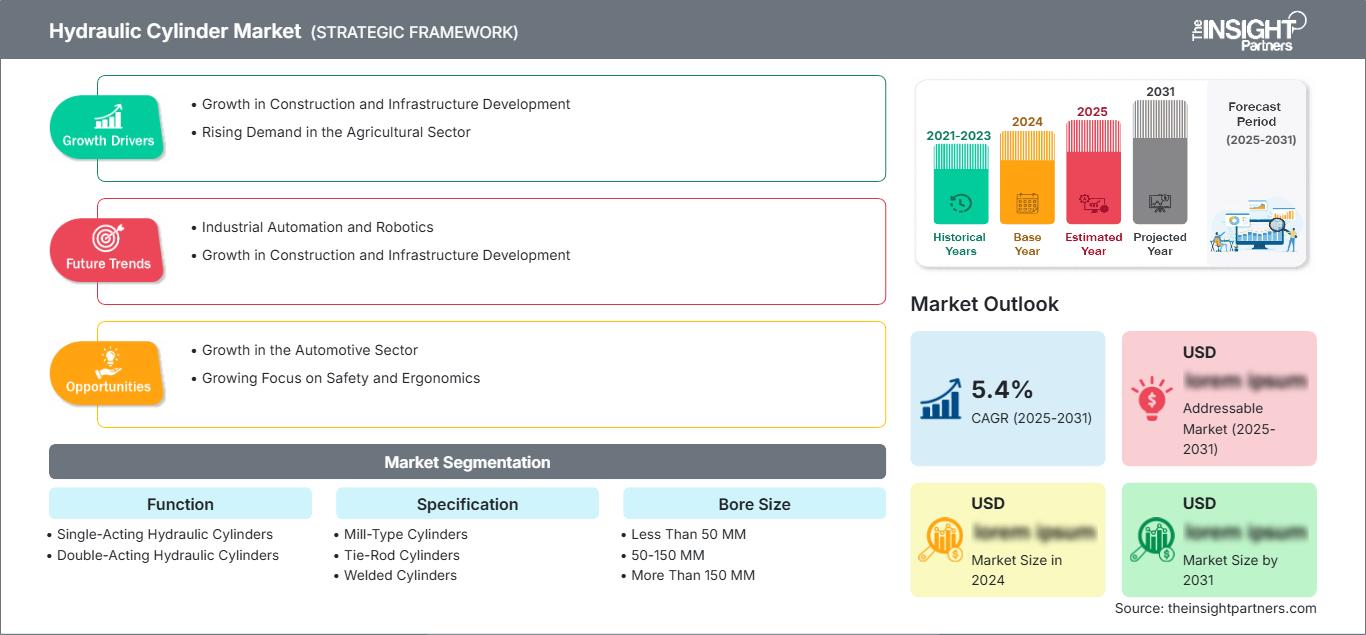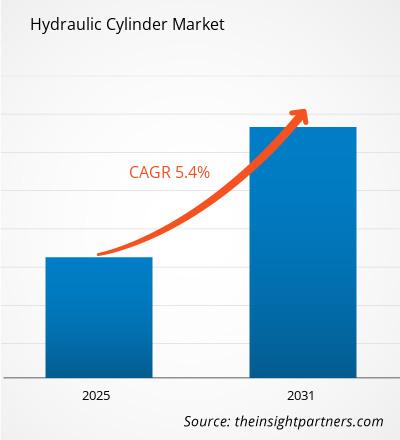页面已更新 :
Jan 2025
预计液压缸市场在 2025 年至 2031 年期间的复合年增长率为 5.4%,市场规模将从 2024 年的 XX 百万美元扩大到 2031 年的 XX 百万美元。
该报告按功能(单作用液压缸、双作用液压缸)、规格(轧机型缸、拉杆缸、焊接缸、伸缩缸)、孔径(小于 50 毫米、50-150 毫米、大于 150 毫米)、应用(工业、移动)、最终用户行业(物料搬运、航空航天和国防、建筑、农业、汽车、石油和天然气、其他)细分。全球分析进一步细分为区域和主要国家。报告以美元提供上述分析和细分的价值。
报告目的
Insight Partners 撰写的《液压缸市场》报告旨在描述当前形势和未来增长、主要驱动因素、挑战和机遇。这将为各业务利益相关者提供见解,例如:
- 技术提供商/制造商:了解不断变化的市场动态并掌握潜在的增长机会,使他们能够做出明智的战略决策。
- 投资者:对市场增长率、市场财务预测以及整个价值链中存在的机会进行全面的趋势分析。
- 监管机构:规范市场政策和警察活动,以尽量减少滥用,维护投资者的信任和信心,并维护市场的完整性和稳定性。
液压缸市场细分功能
- 单作用液压缸
- 双作用液压缸
规格
- 铣削型油缸
- 拉杆油缸
- 焊接油缸
- 伸缩油缸
缸径
- 小于 50 毫米
- 50-150 毫米
- 大于 150 毫米
应用
- 工业
- 移动
最终用户行业
- 物料搬运
- 航空航天和国防
- 建筑
- 农业
- 汽车
- 石油和天然气
自定义此报告以满足您的要求
您将免费获得任何报告的定制,包括本报告的部分内容,或国家级分析、Excel 数据包,以及为初创企业和大学提供超值优惠和折扣
液压缸市场: 战略洞察

- 获取本报告的主要市场趋势。这个免费样本将包括数据分析,从市场趋势到估计和预测。
液压缸市场增长动力
- 建筑和基础设施建设的增长:全球(尤其是新兴经济体)的高城市化率,加上基础设施项目的大幅增长,是液压缸行业扩张的重要驱动力。随着城市人口的增长,对住房、交通和公共设施的需求激增,需要大规模的建设活动,而这些活动需要重型机械。道路建设、建筑和采矿等行业处于这一发展的前沿,严重依赖挖掘机、起重机、装载机和推土机等设备,而这些设备的运行都依赖于液压缸。液压缸是提供提升和移动重物所需动力的关键部件,能够高效地执行这些领域的任务。
- 农业领域的需求不断增长:液压缸在精准农业和拖拉机、收割机和犁等现代农具的运行中发挥着关键作用,能够以卓越的精度和效率完成包括提升、转向和控制农具在内的一系列重要任务。随着农业领域越来越多地采用先进技术来提高生产力和可持续性,人们明显转向更高效、更自动化的农业设备。这一趋势是由最大化产量、降低劳动力成本和最小化环境影响的需求驱动的,促使农民投资于集成液压系统以实现最佳性能的最先进机械。
液压缸市场未来趋势
- 工业自动化和机器人:制造业和采矿业等行业日益增长的自动化趋势极大地推动了对液压缸的需求,液压缸是各种自动化系统运行不可或缺的一部分。液压缸是工业机器人的重要组成部分,提供执行复杂任务所需的力量和精度,从提升和移动重物到执行复杂的装配过程。随着各行各业越来越多地采用机械臂和自动化装配线来提高生产率、降低运营成本和提高安全性,对液压动力系统的依赖也持续上升。
- 建筑和基础设施发展的增长:随着全球尤其是新兴经济体城市化和基础设施项目的不断推进,对使用液压缸的重型机械的需求强劲。为挖掘机、起重机和推土机等建筑设备供应液压系统存在商机,这些设备对于建设道路、桥梁和住宅区至关重要。随着政府投资基础设施以支持经济增长,公司可以通过提供针对现代建筑需求的创新液压解决方案来利用这一需求。
液压缸市场机遇
- 汽车行业的增长:液压缸用于汽车中的许多升降装置 - 从公共汽车和卡车的升降装置到悬架系统,以及最近的电动汽车制造。因此,制造商进军电动汽车、自动驾驶汽车和汽车零部件制造领域的动力正在推动对液压零部件的需求。
- 日益重视安全和人体工程学:随着各行各业优先考虑工人安全和人体工程学设计,液压缸制造商有机会开发增强安全功能的系统,例如过载保护和改进的控制机制。通过解决安全问题和推广人体工程学解决方案,公司可以在市场中脱颖而出,并吸引寻求提高工作场所安全性的客户。
液压缸市场
The Insight Partners 的分析师已详尽阐述了预测期内影响液压缸市场的区域趋势和因素。本节还讨论了北美、欧洲、亚太地区、中东和非洲以及南美和中美洲的液压缸市场细分和地域分布。
液压缸市场报告范围
| 报告属性 | 细节 |
|---|---|
| 市场规模 2024 | US$ XX million |
| 市场规模 2031 | US$ XX Million |
| 全球复合年增长率 (2025 - 2031) | 5.4% |
| 历史数据 | 2021-2023 |
| 预测期 | 2025-2031 |
| 涵盖的领域 |
By 功能
|
| 覆盖地区和国家 | 北美
|
| 市场领导者和主要公司简介 |
|
液压缸市场参与者密度:了解其对业务动态的影响
液压缸市场正在快速增长,这得益于终端用户需求的不断增长,而这些需求的驱动因素包括消费者偏好的演变、技术进步以及对产品优势的认知度的提升。随着需求的增长,企业正在扩展产品线,不断创新以满足消费者需求,并抓住新兴趋势,从而进一步推动市场增长。

- 获取 液压缸市场 主要参与者概述
主要卖点
- 全面覆盖:本报告全面涵盖了对液压缸市场的产品、服务、类型和最终用户的分析,提供了整体格局。
- 专家分析:本报告基于对行业专家和分析师的深入了解而编写。
- 最新信息:由于涵盖了最新信息和数据趋势,本报告确保了业务相关性。
- 定制选项:本报告可以根据特定客户要求进行定制,并恰如其分地适应业务策略。
因此,液压缸市场研究报告可以帮助引领解读和理解行业情景和增长前景的线索。尽管可能存在一些合理的担忧,但本报告的总体优势往往大于劣势。
- 历史分析(2 年)、基准年、预测(7 年)及复合年增长率
- PEST和SWOT分析
- 市场规模、价值/数量 - 全球、区域、国家
- 行业和竞争格局
- Excel 数据集
近期报告
客户评价
购买理由
- 明智的决策
- 了解市场动态
- 竞争分析
- 客户洞察
- 市场预测
- 风险规避
- 战略规划
- 投资论证
- 识别新兴市场
- 优化营销策略
- 提升运营效率
- 顺应监管趋势
我们的客户































87-673-9708

ISO 9001:2015



 获取免费样品 - 液压缸市场
获取免费样品 - 液压缸市场